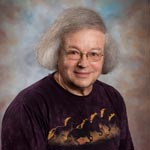Bradley C. Antanaitis

Degrees
- B.A., Northeastern University
- M.Ph.,Ph.D., Columbia University
Research interests: structure and function of metal-bearing proteins and enzymes isolated from sources as diverse as photosynthetic bacteria, leguminous plants and pregnant sows. These proteins participate in a wide variety of fundamental life processes including photosynthetic electron transport, iron and oxygen transport, and enzymatic catalysis. Since all of the proteins contain one or more metal atoms, they are amenable to study by an arsenal of magnetic resonance and spectroscopic techniques, studies frequently supplemented with biochemical data obtained through isoelectric focusing or enzymatic assay. Where applicable, the dynamical aspects of a biopolymer’s behavior also are probed by measuring electron transfer rates, or the rates at which small molecules “hop” on and off their larger biomolecular cousins. Ultimately these results may be used to develop low molecular weight analogs that mimic the protein’s function. Synthetic analogs, which closely resemble the protein’s active site, also aid in the elucidation of the protein’s structure.
Much of this research has been carried out off-campus, primarily at the Albert Einstein College of Medicine and at Princeton and Cornell Universities. However, the acquisition (jointly with the Department of Chemistry) of a 300 MHz pulsed Fourier-transform nuclear magnetic resonance (NMR) spectrometer, housed in the Hugel Science Center, and the establishment of a biophysical laboratory in the basement of Hugel Science Center now make it possible to conduct a greater proportion of the research on campus.
Student candidates with a variety of interests and backgrounds are welcome to participate in this work for honors or independent research. Several students have already successfully completed independent research projects involving the following types of work: isolation of an iron protein from uterine flushings of pseudopregnant gilts, biochemical manipulation of protein samples prior to their physicochemical characterization, characterization of protein active sites by magnetic resonance (EPR and NMR) techniques, and development of theoretical models to account for the electronic and magnetic properties of spin-coupled binuclear iron centers. Thomas Day ’16 worked with Brad in the summer of 2015.